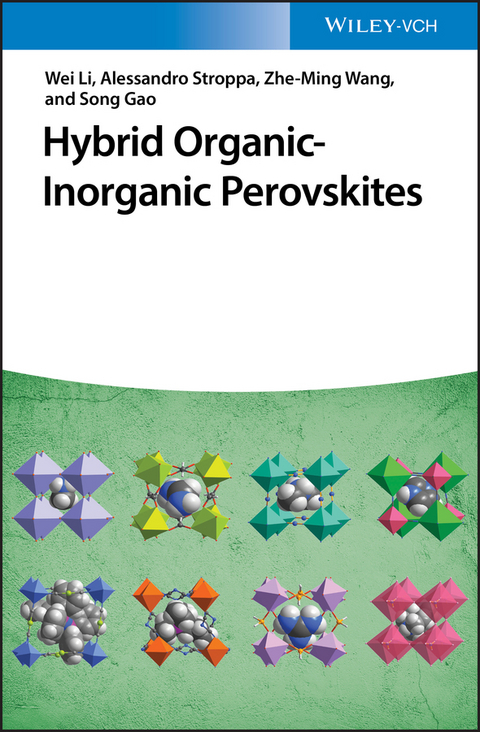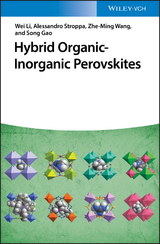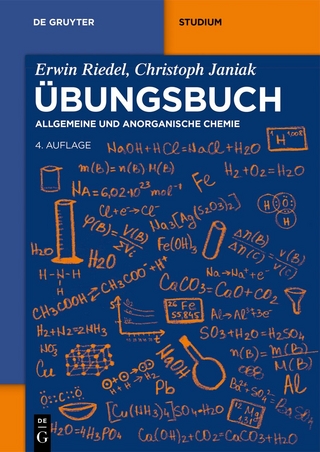Hybrid Organic-Inorganic Perovskites
Wiley-VCH (Verlag)
978-3-527-34431-4 (ISBN)
Prof. Wei Li is a full Professor of Materials Chemistry and Physics at Huazhong University of Science and Technology (HUST). He obtained his PhD in 2008 from Fujian Institute of Research on the Structure of Matter, Chinese Academy of Sciences. After a post-doctoral training at University of Cambridge, he took a faculty position in the School of Physics at HUST. He has published more than 50 peer-viewed papers and several awards including the "100 Talents of Hubei Province" in 2016. In 2014, he served as the Guest Editor of the Special Issue "Metal-Organic Framework Materials" for the journal APL Materials. Dr. Alessandro Stroppa is a permanent research scientist in the CNR Institute SPIN, Italy. He received his PhD from University of Trieste, Italy in 2005 and continued his theoretical work in University of Trieste and University of Vienna during 2005-2009. He has published more than 65 peer-viewed papers and received several honors including the "Best 2008 New Journal of Physics Collection" and the Research Highlight talk at EUROMAT 2013 Prof. Song Gao is a Cheung-Kong Professor of the College of Chemistry and Molecular Engineering, Peking University. He obtained all his degrees in Peking University and became a faculty member after completing PhD in 1988. He worked in RWTH Aachen as a Humboldt Research Fellow from 1995 to 1997. He has published more than 470 papers with over 20,450 citations and an h-index of 76, and elected as one of Highly Cited Researchers by Thomson Reuters in 2014, 2015 and 2016. He was elected to be a Fellow of the Chinese Academy of Sciences, the World Academy of Sciences (TWAS) and the Royal Society of Chemistry (FRSC). Prof. Zhe-Ming Wang earned his PhD degree from Peking University in 1996. He had been a COE visiting associate professor in the Institute for Molecular Science, Japan, during 2002-2003. He has published more than 100 papers with other authors. Prof. Anthony K. Cheetham FRS is the Goldsmiths' Professor in Materials Science at the University of Cambridge. He was educated in the University of Oxford, where he received his PhD in 1969. He became a lecturer in 1969 in Oxford and promoted to be a Reader in 1990. He moved to the University of California, Santa Barbara, to take up a position as Professor of Materials and Chemistry in 1991. In 2007, he moved back to the University of Cambridge. He has published more than 630 ISI publications (gaining over 30,000 citations with an h-index of 85), plus 6 books and several patents. His distinction as a scholar has been recognized by election to numerous academies which includes the Royal Society, TWAS, the Academia Europaea, the German National Academy of Sciences, the German National Academy of Science and Engineering and the American Academy of Arts and Sciences. He has also been awarded a large number of international prizes which include the European Research Council Advanced Investigator Award, TWAS Medal Lecturer and the Humboldt Research Award. In 2015 he became Vice-President and Treasurer of the Royal Society.
1 Introduction to hybrid organic-inorganic perovskites 1
1.1 Perovskite oxides 1
1.2 Evolution from perovskite oxides to HOIPs 3
1.3 Classification and chemical variations of HOIPs 5
1.4 Structure, symmetry and property features of HOIPs 6
1.4.1 General trend 6
1.4.2 Ion radius mismatch and tolerance factor 9
1.4.3 Phase transitions 10
2 Hybrid halide perovskites 15
2.1 Synthesis and chemical diversity 15
2.2 Symmetry and structures 19
2.3 Phase transitions 26
2.4 Physical properties 31
2.4.1 Semiconductivity and bandgap structures 31
2.4.2 Transport properties and photovoltaics 37
2.4.3 Laser physics 54
2.4.4 Light-emitting diodes 60
2.4.5 Photodetectors 65
2.4.6 Ferroelectricity and Rashba effect 69
2.4.7 Mechanical properties 73
2.4.8 Thermal conductivity 78
2.4.9 Caloric effects 80
2.4.10 Other properties 82
3 Hybrid formate perovskites 92
3.1 Synthesis and chemical diversity 92
3.2 Symmetries and structures 95
3.3 Phase transitions and order-disorder 103
3.4 Physical properties 107
3.4.1 Magnetism 107
3.4.1.1 Spin-canting and JT effect 107
3.4.1.2 Spin-flop 113
3.4.1.3 Quantum tunneling 116
3.4.2 Dielectricity 117
3.4.3 Ferroelectricity 121
3.4.4 Ferroelasticity 132
3.4.5 Multiferroicity 138
3.4.6 Mechanical properties 147
3.4.7 Thermal expansion 159
3.4.8 Caloric effects 165
4
Hybrid azide perovskites 179
4.1 Synthesis and structures 179
4.2 Phase transitions 184
4.3 Physical properties 194
4.3.1 Magnetism 194
4.3.2 Dielectricity 197
4.3.3 Antiferroelectricity and ferroelasticity 204
4.3.4 Thermal expansion 2074.3.5 Mechanical properties 208
5 Hybrid dicyanomide perovskites 213
5.1 Synthesis and structures 213
5.2 Phase transitions 217
5.3 Physical properties 221
5.3.1 Dielectricity 221
5.3.2 Optical properties and second-harmonic generation effects 224
5.3.3 Magnetism 225
5.3.4 Mechanical properties and thermal expansion 227
5.3.5 Caloric effects 230
6 Hybrid cyanide perovskites 234
6.1 Synthesis and structures 234
6.2 Phase transitions 239
6.3 Physical properties 248
6.3.1 Second-harmonic generation 248
6.3.2 Dielectricity 248
6.3.3 Ferroelectricity 253
7 Hybrid dicyanometallate and borohydride perovskites 258
7.1 Hybrid dicyanometallate perovskites 258
7.1.1 Synthesis, structures and phase transitions 258
7.1.2 Physical properties 261
7.2 Hybrid boronhydride perovskites 263
8 Hybrid hypophosphite perovskites 264
8.1 Synthesis 264
8.2 Symmetries and structures 266
8.3 Phase transitions 268
8.4 Physical properties 270
8.4.1 Mechanical properties 270
8.4.2 Magnetism 271
9 Other perovskite-like hybrid materials and metal-free perovskites 274
9.1 Hybrid organic-inorganic perchlorates 274
9.1.1 Synthesis, structures and phase transitions 274
9.1.2 Physical properties 279
9.1.2.1 Mechanical properties 279
9.1.2.2 Dielectric properties 282
9.1.2.3 High energetic properties 284
9.2 Hybrid organic-inorganic tetrafluoroborates 286
9.2.1 Synthesis, structures and phase transitions 286
9.2.2 Physical properties 289
9.3 Metal-free perovskites 290
9.3.1 Synthesis, structures and electronic properties 290
9.3.2 Phase transitions 296
9.3.3 Physical properties 297
9.3.3.1 Photoluminescence 297
9.3.3.2 Ferroelectricity and dielectricity 398
9.3.3.3 Mechanical properties 302
10 Concluding remarks and future perspectives 310
1 Introduction to hybrid organic-inorganic perovskites 1
1.1 Perovskite oxides 1
1.2 Evolution from perovskite oxides to HOIPs 3
1.3 Classification and chemical variations of HOIPs 5
1.4 Structure, symmetry and property features of HOIPs 6
1.4.1 General trend 6
1.4.2 Ion radius mismatch and tolerance factor 9
1.4.3 Phase transitions 10
2 Hybrid halide perovskites 15
2.1 Synthesis and chemical diversity 15
2.2 Symmetry and structures 19
2.3 Phase transitions 26
2.4 Physical properties 31
2.4.1 Semiconductivity and bandgap structures 31
2.4.2 Transport properties and photovoltaics 37
2.4.3 Laser physics 54
2.4.4 Light-emitting diodes 60
2.4.5 Photodetectors 65
2.4.6 Ferroelectricity and Rashba effect 69
2.4.7 Mechanical properties 73
2.4.8 Thermal conductivity 78
2.4.9 Caloric effects 80
2.4.10 Other properties 82
3 Hybrid formate perovskites 92
3.1 Synthesis and chemical diversity 92
3.2 Symmetries and structures 95
3.3 Phase transitions and order-disorder 103
3.4 Physical properties 107
3.4.1 Magnetism 107
3.4.1.1 Spin-canting and JT effect 107
3.4.1.2 Spin-flop 113
3.4.1.3 Quantum tunneling 116
3.4.2 Dielectricity 117
3.4.3 Ferroelectricity 121
3.4.4 Ferroelasticity 132
3.4.5 Multiferroicity 138
3.4.6 Mechanical properties 147
3.4.7 Thermal expansion 159
3.4.8 Caloric effects 165
4
Hybrid azide perovskites 179
4.1 Synthesis and structures 179
4.2 Phase transitions 184
4.3 Physical properties 194
4.3.1 Magnetism 194
4.3.2 Dielectricity 197
4.3.3 Antiferroelectricity and ferroelasticity 204
4.3.4 Thermal expansion 2074.3.5 Mechanical properties 208
5 Hybrid dicyanomide perovskites 213
5.1 Synthesis and structures 213
5.2 Phase transitions 217
5.3 Physical properties 221
5.3.1 Dielectricity 221
5.3.2 Optical properties and second-harmonic generation effects 224
5.3.3 Magnetism 225
5.3.4 Mechanical properties and thermal expansion 227
5.3.5 Caloric effects 230
6 Hybrid cyanide perovskites 234
6.1 Synthesis and structures 234
6.2 Phase transitions 239
6.3 Physical properties 248
6.3.1 Second-harmonic generation 248
6.3.2 Dielectricity 248
6.3.3 Ferroelectricity 253
7 Hybrid dicyanometallate and borohydride perovskites 258
7.1 Hybrid dicyanometallate perovskites 258
7.1.1 Synthesis, structures and phase transitions 258
7.1.2 Physical properties 261
7.2 Hybrid boronhydride perovskites 263
8 Hybrid hypophosphite perovskites 264
8.1 Synthesis 264
8.2 Symmetries and structures 266
8.3 Phase transitions 268
8.4 Physical properties 270
8.4.1 Mechanical properties 270
8.4.2 Magnetism 271
9 Other perovskite-like hybrid materials and metal-free perovskites 274
9.1 Hybrid organic-inorganic perchlorates 274
9.1.1 Synthesis, structures and phase transitions 274
9.1.2 Physical properties 279
9.1.2.1 Mechanical properties 279
9.1.2.2 Dielectric properties 282
9.1.2.3 High energetic properties 284
9.2 Hybrid organic-inorganic tetrafluoroborates 286
9.2.1 Synthesis, structures and phase transitions 286
9.2.2 Physical properties 289
9.3 Metal-free perovskites 290
9.3.1 Synthesis, structures and electronic properties 290
9.3.2 Phase transitions 296
9.3.3 Physical properties 297
9.3.3.1 Photoluminescence 297
9.3.3.2 Ferroelectricity and dielectricity 398
9.3.3.3 Mechanical properties 302
10 Concluding remarks and future perspectives 310
1 Introduction to hybrid organic-inorganic perovskites 1
1.1 Perovskite oxides 1
1.2 Evolution from perovskite oxides to HOIPs 3
1.3 Classification and chemical variations of HOIPs 5
1.4 Structure, symmetry and property features of HOIPs 6
1.4.1 General trend 6
1.4.2 Ion radius mismatch and tolerance factor 9
1.4.3 Phase transitions 10
2 Hybrid halide perovskites 15
2.1 Synthesis and chemical diversity 15
2.2 Symmetry and structures 19
2.3 Phase transitions 26
2.4 Physical properties 31
2.4.1 Semiconductivity and bandgap structures 31
2.4.2 Transport properties and photovoltaics 37
2.4.3 Laser physics 54
2.4.4 Light-emitting diodes 60
2.4.5 Photodetectors 65
2.4.6 Ferroelectricity and Rashba effect 69
2.4.7 Mechanical properties 73
2.4.8 Thermal conductivity 78
2.4.9 Caloric effects 80
2.4.10 Other properties 82
3 Hybrid formate perovskites 92
3.1 Synthesis and chemical diversity 92
3.2 Symmetries and structures 95
3.3 Phase transitions and order-disorder 103
3.4 Physical properties 107
3.4.1 Magnetism 107
3.4.1.1 Spin-canting and JT effect 107
3.4.1.2 Spin-flop 113
3.4.1.3 Quantum tunneling 116
3.4.2 Dielectricity 117
3.4.3 Ferroelectricity 121
3.4.4 Ferroelasticity 132
3.4.5 Multiferroicity 138
3.4.6 Mechanical properties 147
3.4.7 Thermal expansion 159
3.4.8 Caloric effects 165
4
Hybrid azide perovskites 179
4.1 Synthesis and structures 179
4.2 Phase transitions 184
4.3 Physical properties 194
4.3.1 Magnetism 194
4.3.2 Dielectricity 197
4.3.3 Antiferroelectricity and ferroelasticity 204
4.3.4 Thermal expansion 2074.3.5 Mechanical properties 208
5 Hybrid dicyanomide perovskites 213
5.1 Synthesis and structures 213
5.2 Phase transitions 217
5.3 Physical properties 221
5.3.1 Dielectricity 221
5.3.2 Optical properties and second-harmonic generation effects 224
5.3.3 Magnetism 225
5.3.4 Mechanical properties and thermal expansion 227
5.3.5 Caloric effects 230
6 Hybrid cyanide perovskites 234
6.1 Synthesis and structures 234
6.2 Phase transitions 239
6.3 Physical properties 248
6.3.1 Second-harmonic generation 248
6.3.2 Dielectricity 248
6.3.3 Ferroelectricity 253
7 Hybrid dicyanometallate and borohydride perovskites 258
7.1 Hybrid dicyanometallate perovskites 258
7.1.1 Synthesis, structures and phase transitions 258
7.1.2 Physical properties 261
7.2 Hybrid boronhydride perovskites 263
8 Hybrid hypophosphite perovskites 264
8.1 Synthesis 264
8.2 Symmetries and structures 266
8.3 Phase transitions 268
8.4 Physical properties 270
8.4.1 Mechanical properties 270
8.4.2 Magnetism 271
9 Other perovskite-like hybrid materials and metal-free perovskites 274
9.1 Hybrid organic-inorganic perchlorates 274
9.1.1 Synthesis, structures and phase transitions 274
9.1.2 Physical properties 279
9.1.2.1 Mechanical properties 279
9.1.2.2 Dielectric properties 282
9.1.2.3 High energetic properties 284
9.2 Hybrid organic-inorganic tetrafluoroborates 286
9.2.1 Synthesis, structures and phase transitions 286
9.2.2 Physical properties 289
9.3 Metal-free perovskites 290
9.3.1 Synthesis, structures and electronic properties 290
9.3.2 Phase transitions 296
9.3.3 Physical properties 297
9.3.3.1 Photoluminescence 297
9.3.3.2 Ferroelectricity and dielectricity 398
9.3.3.3 Mechanical properties 302
10 Concluding remarks and future perspectives 310
| Erscheinungsdatum | 12.07.2019 |
|---|---|
| Verlagsort | Weinheim |
| Sprache | englisch |
| Maße | 170 x 244 mm |
| Gewicht | 728 g |
| Themenwelt | Naturwissenschaften ► Chemie ► Anorganische Chemie |
| Technik ► Elektrotechnik / Energietechnik | |
| Technik ► Maschinenbau | |
| Schlagworte | Anorganische Strukturen • Chemie • Chemistry • Energie • Energy • Inorganic Structures • Materialeigenschaften • Materials Science • Materialwissenschaften • Perovskit • properties of materials • Solarenergie • Solarenergie u. Photovoltaik • Solar Energy & Photovoltaics |
| ISBN-10 | 3-527-34431-4 / 3527344314 |
| ISBN-13 | 978-3-527-34431-4 / 9783527344314 |
| Zustand | Neuware |
| Haben Sie eine Frage zum Produkt? |
aus dem Bereich




